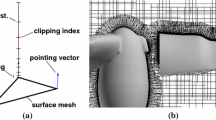Abstract
This paper describes an overset approach that comprised virtual boundary-layer-like near-body grid coupled with an off-body adaptive mesh refinement far-field mesh for viscous fluids simulations. Unlike most a priori grid generation systems for the Reynolds-Averaged Navier–Stokes equations, the strand meshing paradigm is automatic, fast and requires little memory to provide boundary-layer coverage. In addition, the stacks of elements implied by the strands can be used to the simulation’s advantage, where they naturally provide a line direction for semi-implicit solving.








Similar content being viewed by others
References
Kallinderis Y, Ward S (1993) Prismatic grid generation for three-dimensional complex geometries. AIAA J 31(10):1850–1856
Delanaye M, Aftosmis MJ, Berger MJ, Liu Y, Pulliam TH (1999) Automatic hybrid-cartesian grid generation for high reynolds number flows around complex geometries. In: 37th AIAA aerospace sciences meeting and exhibit, Reno. AIAA Paper 99-0777
Meakin RL, Wissink AM, Chan WM, Pandya SA, Sitaraman J (2007) On strand grids for complex flows. In: 18th AIAA computational fluid dynamics conference, Miami. AIAA Paper 2007-3834
Wissink AM, Katz AJ, Chan WM, Meakin RL (2009) Validation of the strand grid approach. In: 19th AIAA computational fluid dynamics conference, San Antonio. AIAA Paper 2009-3792
Moro D, Nguyen C, Peraire J, Drela M (2013) Advances in the development of a high order, viscous-inviscid interaction solver. In: 21st AIAA computational fluid dynamics conference, San Diego. AIAA Paper 2013-2943
Drela M (2013) Three-dimensional integral boundary layer formulation for general configurations. In: 21st AIAA computational fluid dynamics conference, San Diego. AIAA Paper 2013-2437
Aubry R, Lohner R (2009) Generation of viscous grids at ridges and corners. Int J Numer Method Eng 77:1247–1289
Ito Y, Shih AM, Soni BK, Nakahashi K (2006) An approach to generate high quality unstructured hybrid meshes. In: 44th AIAA aerospace sciences meeting and exhibit, Reno. AIAA Paper 2006-0530
Haimes R, Drela M (2012) On the construction of aircraft conceptual geometry for high fidelity analysis and design. In: 50th AIAA aerospace sciences meeting and exhibit, Nashville. AIAA Paper 2012-0683
OpenCASCADE. http://www.opencascade.org
Haimes R, Follen G (1998) Computational analysis programming interface. In: Proceedings of the 6th international conference on numerical grid generation in computational field simulations
Wissink AM, Katz AJ, Sitaraman J (2012) PICASSO: a meshing infrastructure for strand-cartesian CFD solvers. In: 30th AIAA applied aerodynamics conference, New Orleans. AIAA Paper 2012-2916
Katz AJ, Wissink AM (2012) Efficient solution methods for strand grid applications. In: 30th AIAA applied aerodynamics conference, New Orleans. AIAA Paper 2012-2779
Wissink AM, Katz, AJ, Sitaraman J, Burgess N, Haimes, R (2013) Progress in automatic viscous meshing from CAD using strand/cartesian meshes. In: 21st AIAA computational fluid dynamics conference, San Diego. AIAA Paper 2013-3075
Acknowledgments
This work was supported through NASA Award #NNX10AJ98G (“Geometric Control for Design Through Analysis”) where Michael J. Aftosmis acted as the technical monitor. Bob Meakin (CREATE-AV) provided the inspiration. William Chan (Nasa Ames) and Andrew Wissink (Army Rotorcraft) provided guidance. Romain Aubry (CREATE-MG) assisted in improving this paper.
Author information
Authors and Affiliations
Corresponding author
Rights and permissions
About this article
Cite this article
Haimes, R. MOSS: multiple orthogonal strand system. Engineering with Computers 31, 453–463 (2015). https://doi.org/10.1007/s00366-014-0375-9
Received:
Accepted:
Published:
Issue Date:
DOI: https://doi.org/10.1007/s00366-014-0375-9




